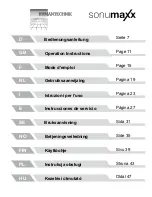
PT3600 Service Manual
3
②
Programmable Button 1
Functions can be assigned to this button through PC software.
③
Programmable button 2
Functions can be assigned to this button through PC software.
④
Emergency Button
Press the button to activate warning tone. Press it again to exit
the emergency alert state. Under the emergency state, all the other
switches and buttons are disabled.
⑤
Channel Selector Knob
Rotate the knob to select channel 1-16.
⑥
On-Off/Volume Control Knob
Turn clockwise until you hear a click to turn the radio power
on. Turn counterclockwise until you hear a click to turn it off.
Rotate it to adjust the volume after turning on the radio.
⑦
LED Indicator
Lights red while transmitting; lights green while receiving;
flashes red when the radio is in low power.
⑧
External Speaker/Microphone Jack Cover
Open the cover; you will see the external speaker/microphone
jacks. External speaker/microphone can be connected to the radio
through these jacks.
Chapter 3 Circuit Description
3.1 Frequency Configuration
The receiver adopts single mixing mode. The first IF is
9.375kHz. The first local oscillator signal of the receiver and the
transmitter signal are generated by the frequency synthesizer.
The reference frequency of the frequency synthesizer is
produced by TCXO.
3.2 Receiver (RX)
RF
AMP
5R
RDA1846
ANT SW
5T
FROM TX
AF POWER AMP
AF
MUTE
MU
T
E
1
2
3
4
5
W558
AF
MUTE
5M
AF
AMP
GND
AF
POWER
AFCN
POWER
SW
3
3
4
4
2
2
1
1
2
SPK JACK
TXD
GND
BA
T
T
3A
sw
CL
K
F
RO
M
M
C
U
DA
T
A
F
R
O
M
M
C
U
BU
S
Y
T
O
M
C
U
MU
T
E
DT
M
F
/B
E
E
P F
R
O
M
M
C
U
5C
Figure 3.1 Receiver Diagram
Front end
The signal coming from the antenna passes through the
RX/TX switch circuit (D511, D515, D508, and D517), and is sent
to pin 15 of U8 (RDA1846) to be demodulated and to output
audio signal.
Audio signal processing
The demodulated audio signal output from U8 (RDA1846)
passes through the volume potentiometer to be adjusted, and then
goes to the audio power amplifier U1 (TDA2822).
Squelch circuit
Output from pin 26 of U8 (RDA1846) is sent to the MCU.
MCU identifies the level of the noise and controls the squelch.
Audio power amplifier
The BTL type audio power amplifier circuit consists of U1
and its peripheral components.
Base electrode of Q621 is the control terminal. High level:
Open; Low level: Close.
The Rx audio signal, voice alert signal, alert tone signal and
warning tone signal are collected and passed through the audio
power amplifier where they are amplified and output to drive the
speaker. The volume of the warning tone is not controlled by the
preset volume level of the radio. Speaker impedance: 16
Ω
.
Note: Any terminal of the speaker should not be grounded!
CTCSS/DCS signal processing
CTCSS/DCS signal output from pin 32 of U8 (RDA1846) is
sent to MCU for decoding.
3.3 Transmitter (TX)
TX power amplification
ANT SW
RF PA
RF PA
DRIVER
DRIVER
PRE
5T
5T
APC
SW
APC
CONTROL
APC FROM MCU
CURRENT
SENSING
POWER SUPPLY
RDA1846
Figure 3.2 Power Amplifier and Antenna Switch Diagram
The modulated RF signal from IC4 (RDA1846) is amplified
by Q506, Q507 and Q502, and is sent to Q501 for power
amplification. Output power of Q501: 4.5W.
Grid bias of Q502 and Q501 is controlled by the APC circuit.
Through changing the grid bias voltage, the Tx output power can
be controlled conveniently.
APC (Automatic Power Control)





































